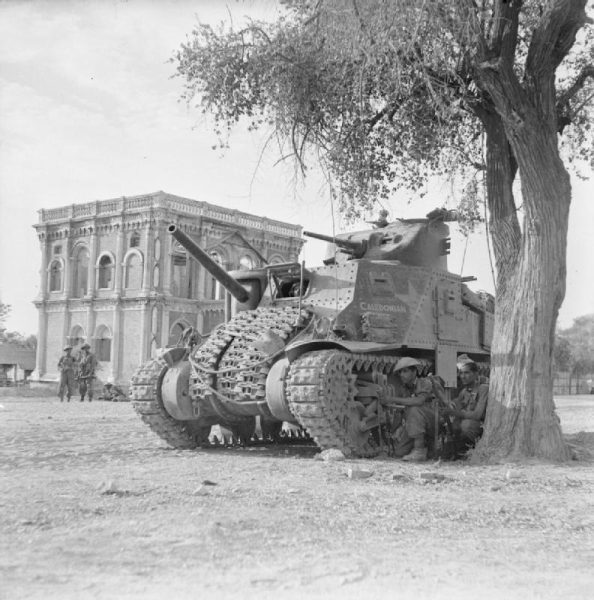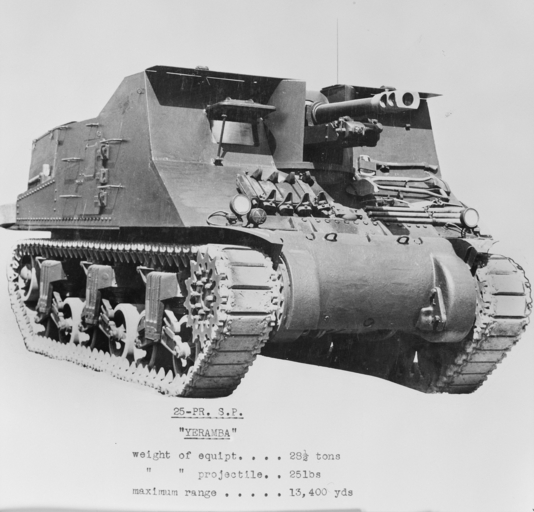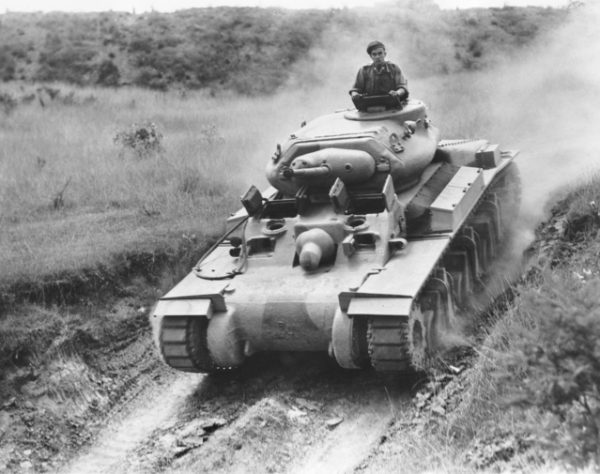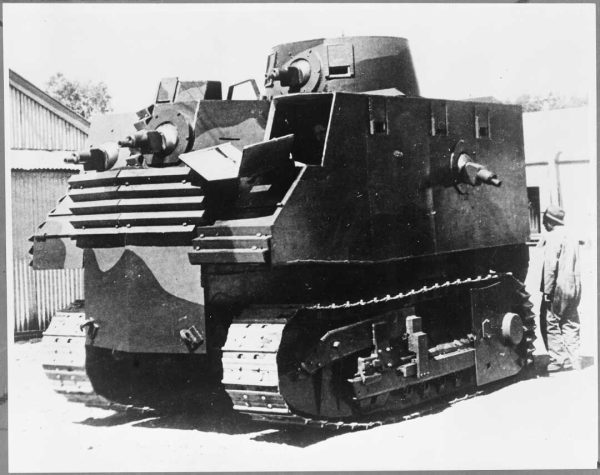In this article we will be discussing some of the tanks and fighting vehicles of the former colonies of the British Empire. During WWII, the British were struggling to supply their own armies, especially when it came to tanks—so most of their then-possessions were forced to fend for themselves. We will be starting with Canada.
The Ram was a tank sometimes described “Canada’s most successful failure.” The Ram was designed in a desperate hurry to have enough tanks in hand for the North African Campaign. In this respect, it is very like the Bishop. It was made on an American M3 Lee chassis, which did give it a good amount of armor. The chassis was made of cast steel armor of around 55 mm, sloped in most places. This chassis was then fitted with a turret that could have used the American 75mm gun, but a six-pounder cannon was mounted instead, because of its better armor-piercing capabilities. The idea was somewhat unrealistic, since these guns were themselves in short supply, which led to a lot of the early tanks being fitted with 40 mm guns instead. This main armament was supplemented with three .30 Browning machine guns from the United States as secondary armament. The vehicle could move at a decent pace of about 40 kilometers per hour. Armor ranged from 25 mm to 87 mm depending on the area, but this was weakened on the first models because of the doors for the machine guns.
The Ram had a lot of variants. Some of them included:
- the Sexton,
- an ammunition carrier called the Wallaby,
- tractors,
- armored recovery vehicles,
- the Badger, which was equipped with a flamethrower,
- and the Kangaroo, which will be discussed separately.
Overall, the Ram was lackluster. It incorporated parts that complicated the design and, in the case of the machine guns, decreased protection, but it was still widely used. Like most early war Canadian vehicles, it was a victim of timing and inexperience. The early versions especially suffered from rushed development, due to the need for these vehicles in the coming battle for Africa and the inexperience of the designers. Eventually, this tank became a very competent vehicle, but by that point many good designs had emerged, which prevented it from standing out.

The next vehicle was the Grant. Named after the American Civil war general and president Ulysses S Grant, the vehicle was based off of the American M3 Lee tank but was quite heavily modified. Like the M3 Lee, it had a very distinctive feature: its two main guns. It had a rotating turret with a 37mm cannon and a hull-mounted 75mm gun. The 37mm was a rather underwhelming armament, but supplied some extra firepower despite its lackluster anti-tank capabilities, which were covered by the 75mm in the hull. It was a very good gun, especially for the early war, against everything from tanks to infantry. It had both HE and AP shells that were both very good for the time. The only downside to the 75mm was that, since it was hull mounted, it could not be used if the target was not almost directly in front of the tank. This made one of the vehicle’s main advantages quite situational, since to shoot something, it either had to be in front of the tank, or the tank had to move.
Nonetheless, the Grant was still very effective. It was also armed with a coaxial .30 caliber belt-fed machine gun attached to the 37 mm turret.
The tank was quite well protected for the time: it had 51 mm of riveted armor on the front and the front of the rotating turret, and 38 mm of armor on the hull sides, turret sides and the rear. To go along with this, it also had two smoke grenade launchers that allowed it to deploy no. 77 smoke grenades as visual shields. The Grant had a crew of 6: a commander, a gunner for each gun, two loaders, and a driver. Despite the positives, the tank did have some downsides, mainly its gigantic height. It came in at 3.1 meters, making it probably the tallest tank to date, and also very easy to see, especially in the desert terrain where it often found itself. It also faced some issues on defense, since its large size made it easier to hit and its hull gun made it almost useless to dig in, as it was still a large target then.

The Grant saw most of its use by Canada and the UK in North Africa. They were used in the famous battle of El-Alamein, where it proved itself to be a formidable weapon for the Allies. This tank was mostly meant to be another stopgap tank, again because the blitzkrieg of France led to a huge blow to the British military, since the British Expeditionary Force’s equipment either had to be left in France or was lost, well . . . in France. As a result, the Dominions and the USA had to pick up the slack: in this case, the M3 Lee became the Grant and was used in the quickly escalating battle for North Africa.
Other than their famous use in North Africa, Grants were also used in the Pacific and Asian fronts by the Indian Army in Burma (see above image) and the
Australians for training, as well as in the early stages of the war in the South Pacific. After the war, especially in Australia, many of these vehicles were repurposed: many were bought and used as tractors and beach recovery vehicles. Due to the large surplus available, however, the Australian Army decided to try to make something with them.
So, in the 1950s, the Australian military made the Yeramba. This was a self-propelled gun that mounted a 25-pound howitzer onto the chassis of a Grant. They were never mass produced, but it’s still a cool note.

The next tank that we will briefly mention is the Sentinel, which was a modification of the Australian Crusader tank, plus a few modifications, mainly around the engine and the machine gun. The tank was given a new Cadillac engine to ensure easy supply of engines even in wartime, and the hull machine gun was water-cooled. Only 65 of the tanks were produced, but it was still a quite good design for the first tank to the Australians.
The last tank in this Article is the best tank of World War II and the modern day: second to none. It is also the best machine—no, the best thing ever made by man. Ready for it?
Meet the Bob Semple tank, built by New Zealand and named after its designer. This tank was armed with six—yes, you read that right, six—Bren light machine guns: five in the hull and one in a rotating turret on top. These Bren guns were distributed throughout the tank: two in the front, one on each side, and one in the back.
You may be thinking to yourself, though: how do you shoot the back machine gun, given that the engine is there? Well, let me tell you: in a fit of pure Kiwi genius, they devised a state-of-the-art mattress that the machine gunner could lie down on, on top of said engine, to fire the gun.
The Bob Semple had near-impenetrable protection: 8 to 12 mm of corrugated iron plate armor. It was built on the chassis of a tracked 6×6 tractor, which could hit a staggering top speed of . . . 24 km/h.
In all seriousness, this thing sucked. It was built due to the isolation of Asia and the Pacific colonies from Britain causing a panic. New Zealand, unlike Australia, decided to try to make its defensive equipment locally instead of buying from the Americans. This was okay when it came to guns, or maybe even artillery, but when it comes to industrially taxing things like tanks, you end up with something like this. The Bob Semple, despite its massive failures, is one of the most well known Commonwealth tanks today, more or less entirely due to the massive amount of jokes and memes about it, which I must admit are quite funny.
Even if this thing could barely withstand a rainstorm, and even though it looks like someone crashed into their garden shed and called it a tank, it’s very funny, so whatever. Despite this failure, I really want New Zealand to try again, so: if there are any New Zealanders reading, please demand your government go for Round 2 of Tank Design. This is for two reasons. Firstly, if it turns out like the Bob Semple again, it would be very funny; secondly, if it fails, it would be good for me, as everyone knows we Australians revel in Kiwi tears. (Disclaimer: Neither I nor the Shield actually endorse bullying New Zealanders. This is purely for internationally comedic purposes.)
